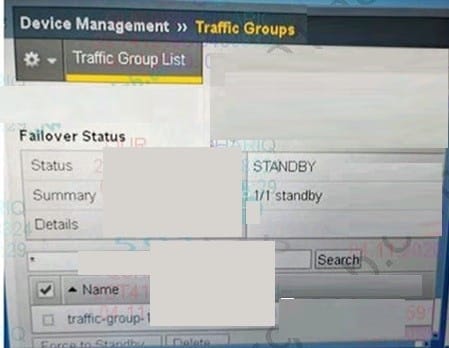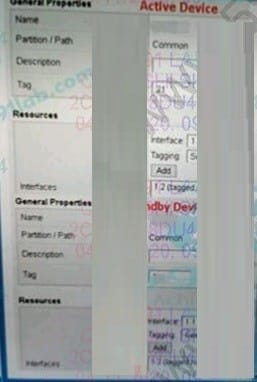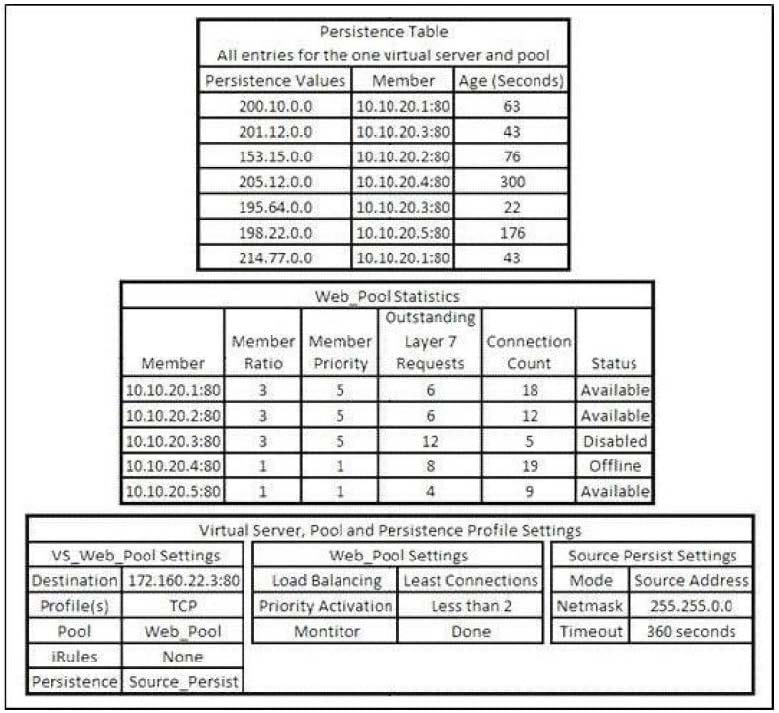Exam Details
Exam Code
:201Exam Name
:TMOS AdministrationCertification
:F5 CertificationsVendor
:F5Total Questions
:254 Q&AsLast Updated
:Apr 15, 2025
F5 F5 Certifications 201 Questions & Answers
-
Question 141:
Refer to the exhibit.

A BIG-IP Administrator needs to fall over the active device. The administrator logs into the Configuration Unity and navigates to Device Management > Traffic Group. However, Force to Standby is greyed out. What is causing this issue?
A. The BIG-IP Administrator is NOT logged into command line to tail over
B. The BIG-IP Administrator is on the Standby Device
C. The BIG-IP Administrator is logged in as root
D. The BIG-IP Administrator is logged in as administrator
-
Question 142:
Refer to the exhibit.

During a planned upgrade lo a BIG-IP HA pair running Active/Standby, an outage to application traffic is reported shortly after the Active unit is forced to Standby Reverting the flower resolves the outage. What should the BIG-IP Administrator modify to avoid an outage during the next for over event?
A. The Tag voice on the Standby device
B. The interface on the Active device to 1.1
C. The Tag value on the Active device
D. The Interface on the Standby device to 1.1
-
Question 143:
A virtual server is defined using a source address based persistence profile. The last five connections were A, B, C, A, C . Given the conditions shown in the graphic, if a client with IP address 205.12.45.52 opens a connection to the virtual server, which member will be used for the connection?

A. 10.10.20.1:80
B. 10.10.20.2:80
C. 10.10.20.3:80
D. 10.10.20.4:80
E. 10.10.20.5:80
-
Question 144:
A BIG-IP Administrator explicitly creates a traffic group on a BIG-IP device.
Which two types of configuration objects can be associated with this traffic group? (Choose two.)
A. Pool Members
B. Virtual Addresses
C. iRules
D. VLANS
E. Application Instances
-
Question 145:
An IT support engineer needs to access and modify Virtual Servers in three partitions (Common /Banking and Dev) daily on a BIG-IP device. The company operates a Least Privilege access policy. What level of access does the IT support engineer need to ensure completion of daily roles?
A. Manager in /common/Banking, and /Dev partitions
B. Application Editor in /Common, /Banking, and /Dev partitions
C. Manager in all partitions
D. Application Editor in all partitions
-
Question 146:
A BIG-IP Administrator finds the following log entry after a report of user issues connecting to a virtual server:
01010201: 2: Inet port exhaustion on 10.70.110.112 to 192.28.123.250:80 (proto 6)
How should the BIG-IP Administrator modify the SNAT pool that is associated with the virtual server?
A. Remove the SNAT pool and apply SNAT Automap.
B. Remove an IP address from the SNAT pool.
C. Add an address to the SNAT pool.
D. Increase the timeout of the SNAT addresses.
-
Question 147:
Users report that traffic is negatively affected every time a BIG-IP device fails over. The traffic becomes stabilized after a few minutes.
What should the BIG-IP Administrator do to reduce the impact of future failovers?
A. Enable Failover Multicast Configuration
B. Set up Failover Method to HA Order
C. Configure MAC Masquerade
D. Configure a global SNAT Listener
-
Question 148:
How is persistence configured?

A. Persistence is an option within each pool's definition.
B. Persistence is a profile type; an appropriate profile is created and associated with virtual server.
C. Persistence is a global setting; once enabled, loadbalancing choices are superceded by the persistence method that is specified.
D. Persistence is an option for each pool member. When a pool is defined, each member's definition includes the option for persistence.
-
Question 149:
You have created a custom profile named TEST2. The parent profile of TEST2 is named TEST1. If additional changes are made to TEST1, what is the effect on TEST2?
A. All changes to TEST1 are propagated to TEST2.
B. Some of the changes to TEST1 may propagate to TEST2.
C. Changes to TEST1 cannot affect TEST2 once TEST2 is saved.
D. When TEST1 is changed, the administrator is prompted and can choose whether to propagate changes to TEST2.
-
Question 150:
What is the purpose of provisioning?
A. Provisioning allows modules that are not licensed to be fully tested.
B. Provisioning allows modules that are licensed be granted appropriate resource levels.
C. Provisioning allows the administrator to activate modules in nonstandard combinations.
D. Provisioning allows the administrator to see what modules are licensed, but no user action is ever required.
Related Exams:
101
Application Delivery Fundamentals201
TMOS Administration301A
BIG-IP LTM Specialist: Architect, Set up and Deploy301B
BIG-IP Local Traffic Manager (LTM) Specialist: Maintain & Troubleshoot771-101
Application Delivery FundamentalsF50-506
F5 FirePass 600 V5F50-531
BIG-IP v10.x LTM Essentials V10.xF50-536
BIG-IP ASM v10.x
Tips on How to Prepare for the Exams
Nowadays, the certification exams become more and more important and required by more and more enterprises when applying for a job. But how to prepare for the exam effectively? How to prepare for the exam in a short time with less efforts? How to get a ideal result and how to find the most reliable resources? Here on Vcedump.com, you will find all the answers. Vcedump.com provide not only F5 exam questions, answers and explanations but also complete assistance on your exam preparation and certification application. If you are confused on your 201 exam preparations and F5 certification application, do not hesitate to visit our Vcedump.com to find your solutions here.